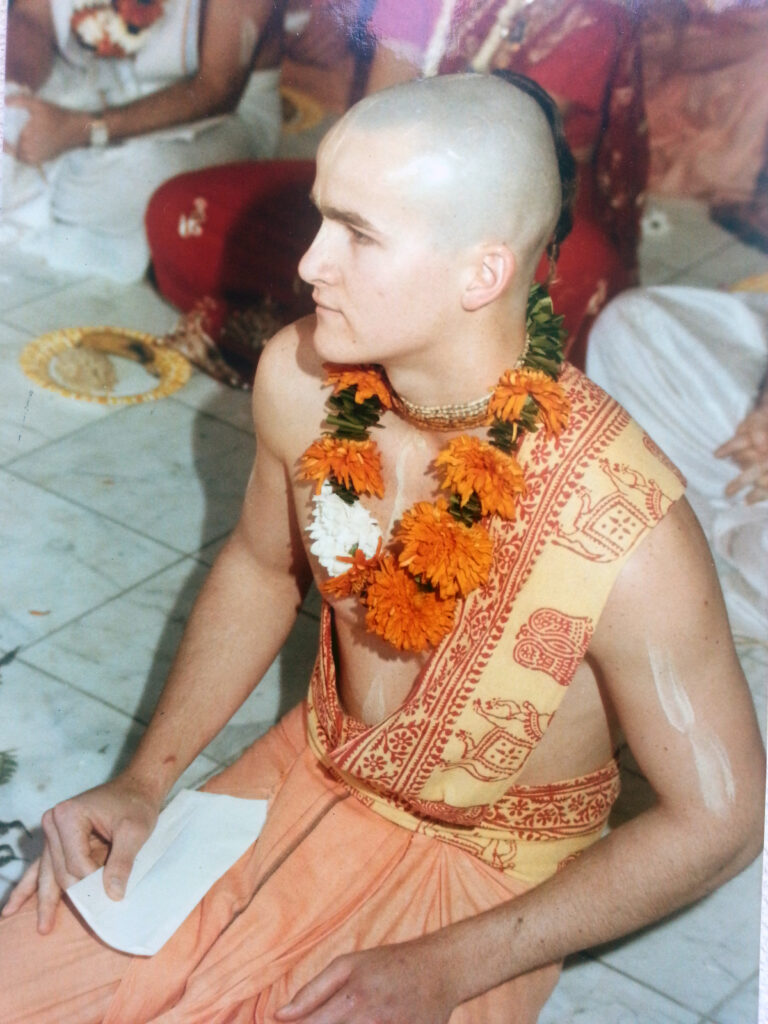Excerpt from my new book, The Alpha Omega Man – A Spiritual Journey to Balanced Masculinity
Available on Amazon 2024
Monk Years
On December 25, 1983, Christmas day, at age 20, I officially became a devotee of Krishna consciousness, and after 6 months of practice, I was initiated into the tradition and given the spiritual name Priyavrata dasa, a Sanskrit name of a famous prince of the tradition who once ruled the Universe. Priya means beloved, and Vrata means determined or a vow. Dasa, means servant. So, one interpretation of the name was “one who is a dear servant of the most determined (the vratas) or the devotees of God,” and another interpretation is “one who is strict in following religious vows.”
Even the name I was given has an Alpha Omega quality to it. Priya is inherently feminine and means “beloved,” “dear,” or “darling” in English, and Vrata is inherently masculine, indicating virility, austerity, and determination.

Paul, now Priyavrata das at age 20
I remember the day that I moved into the ashrama just like it was yesterday. I was so excited that the night before I was to move in, I vowed to chant 64 rounds of the maha-mantra. To the unfamiliar, that is 6,912 complete repetitions of the maha-mantra: Hare Krishna, Hare Krishna, Krishna Krishna, Hare Hare, Hare Rama, Hare Rama, Rama Rama, Hare Hare.
It took me about 10 hours to complete this task, but I was determined to do so because I wanted to make sure that when I offered my body, mind, and soul to Krishna (God), it would be pure and acceptable. On my first night at the ashram, I slept in my sleeping bag on the temple room floor. But I was so enthusiastic about rising early for my first experience of morning prayers that I could not sleep but lay awake all night, listening to and appreciating the silence of the forest outside.
The next day, we all gathered outside to greet the visiting guru, Bhavananda Goswami. His actual legal name was Charles Bacis, who, before joining the Hare Krishna movement, was a small-time New York movie director who once did a film with Andy Warhol called Chelsea Girls. With the eyes of a gullible neophyte, I had visions that he had just descended from the spiritual sky, and, like the other monks, we fawned over every word he spoke. “Bhavs,” as he was affectionately known by his peers, came across as a pure soul, but many years later, it would be revealed that he was, in fact, an out-of-control homosexual, narcissistic tyrant, pedophile, playing the role of a spiritual leader. Bhavananda was charismatic and a great public speaker but had a sleazy private life that eventually unfolded in all its ugliness, and he was eventually stripped of his “guru” status and cast out temporarily by the society he once ruled. However, soon enough, he wiggled his way back into an influential role, probably because he had dirt on others.
I was now an apprentice monk, or bhakta, but still had my long locks of hair. I begged the other monks to shave my head. When they finally did, I felt as if my former self was now lying on the floor of the bathroom. That dirty hair represented everything that was wrong with my past.
Life in the Ashram
With my head now cleanly shaved, monk Kein Craig, whom I knew back then as Chaturbhuja, showed me how to put on tilak, the sacred clay lines adorning the forehead of Hindus, and the saffron robes of a monk.
We lived a very regulated life in the ashram. There were no beds; we slept on the hard floor in a sleeping bag. We all rose at 3:30 am, took a cool shower, and attended the morning prayers that started at 4:30. We chanted and danced enthusiastically until 5:15 am, at which time we would all then do personal meditation of the maha mantra, chanting Hare Krishna Hare Krishna Krishna Krishna Hare Rama Hare Rama Rama Rama Hare Hare one time on each of the 108 string of beads that we carried in our bed bag. We did 16 of those “rounds” every morning. After completing our personal meditation, we once more gathered for more congregational prayers at 7:30 a.m., and then at 8 a.m., we sat down for a morning lecture given by a senior monk. At around 9 a.m., we sat down on the floor crossed-legged to receive our breakfast on a stainless-steel plate, which consisted of vegetable and rice stew (Kitchuri), fruits, nuts, pocket bread (puris), and hot milk from the cows. We did not use utensils to eat but were trained to use our right hand instead, which is traditional in Indian cuisine. Apparently, the textual cues you get from touching your food assist in the digestive process.
After breakfast, we went about our daily chores, which consisted of tending to the cows, cleaning the barn, gardening, cleaning the temple, washing pots, or preparing lunch for the monks or for the free food distribution a team of monks would do every day for the homeless in Sydney. We gathered again for lunch at exactly 1 p.m. and then for dinner at 7 p.m. At around 8:30 p.m., we again drank hot milk from the hand-milked farm cows. There was no television, no radio, and no newspapers allowed. We studied the books of the founder and the ancient scriptures of India. We were fully immersed in the spiritual culture and did this without fail every day of the week, and everyone seemed content.
All the boys wore traditional yogi underwear called kaupins,[1] which consisted of two pieces of thin cotton cloth that we would keep on underneath another thicker cloth that wrapped around our waists, known as a gumpcha (cotton towel), as we showered. We never showered naked. Mandana told me, “At night time, “You need to make sure your kaupins are extra tight to avoid unintended erections.”
You will be surprised to learn that most of the characters in the ashram came from tough backgrounds. Characters like Madhu, Bhoja, Mandana, Krishna Kirtan, Bhagavan, Gopati, Havir Hari, Janmashtami, Vegavan, Guruttama, Jagadish, and Dharmaraja (Their spiritual names), to name just a few, were all the kind of loudmouths you’d see at your typical cricket match chugging down beers. We were your stereotypical Aussie male, strong-bodied, determined, loud, and a bit rough around the edges, but here we all were, immersed in this foreign Indian spiritual culture and slowly but surely becoming more refined and cleaner in our behavior and more empathic in our attitude. Noticing this phenomenon, I asked Mandana (Sterny), “Why did we get this opportunity and not other people who are probably more qualified?” He told me frankly, “Well, maybe because God starts at the bottom of the barrel.” It was like we had all been so burned out by life that this was our last chance to regain some normalcy. Radical as it seemed to an outsider, for us, it was a golden opportunity to develop our full human potential. Granted, there were the occasional effeminate characters in the ashram and even people I would never even considered befriending prior to my life as a monk, but now that we all had the same goal of self-realization, those things that would normally separate us dissolved into obscurity and we became spiritual brothers and sisters. Even those few boys who were obviously homosexual before becoming monks were transcending their physical identity and sexual urges and developing as balanced human beings. According to the teachings of the Vedas, in the spiritual world, we are both a perfect balance of male and female energy. It is only in this material world that we are forced into a single gender identity in order to learn the lessons of that particular expression.
All the men and women in the ashram were focused on the goal of self-realization, and it was clearly showing in our effulgent smiling faces. It was a powerful lesson that stayed with me for the rest of my life. Only when we identify with our higher self can we achieve true happiness and unity.
From an external view, we might have appeared as weak men running from responsibility, but truth be told, we were like spiritual marines, working under austere and challenging conditions and having to be constantly on guard against the “enemy,” lusty desire.
[1] A loincloth worn by men in the Indian subcontinent as underclothing, it is still commonly worn by South Asian pehlwano (wrestlers) while exercising or sparring in a dangal.


Leave a Reply
You must be logged in to post a comment.